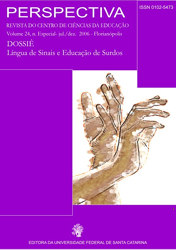Quando surdos nomeiam figuras: processos quirêmicos, semânticos e ortográficos
DOI:
https://doi.org/10.5007/%25xResumo
o Teste de Nomeação de Figuras por Escolha (TNF-Escolha) avalia a habilidade de escolher palavras escritas para nomear figuras e analisa processos quirêmicos, ortográficos e semânticos envolvidos. Com outros testes como de compreensão de sinais (IVRSL) e competência de leitura (TCLPP), foi aplicado a 320 surdos de seis a 45 anos, de 1a série do Ensino Fundamental ala. do Médio de quatro escolas semibilíngües paulistas. Corroborando a hipótese de que o léxico quirêmico indexa o léxico ortográfico ao léxico pictorial, paralexias quirêmicas significativas revelaram que, ao escolher palavras para nomear figuras, surdos primeiro evocam o sinal da figura e, depois, a palavra do sinal. Corroborando a validade do TNF em induzir paralexias, quanto maior a competência de leitura no TCLPP, menos paralexias ortográficas no TNF; e quanto maior o vocabulário de sinais no TVRSL, menos paralexias quirêmicas no TNE.
Downloads
Publicado
Como Citar
Edição
Seção
Licença
Esta revista proporciona acesso público a todo seu conteúdo, seguindo o princípio de que tornar gratuito o acesso a pesquisas gera um maior intercâmbio global de conhecimento. Tal acesso está associado a um crescimento da leitura e citação do trabalho de um autor. Para maiores informações sobre esta abordagem, visite Public Knowledge Project, projeto que desenvolveu este sistema para melhorar a qualidade acadêmica e pública da pesquisa, distribuindo o Open Journal Sistem (OJS) assim como outros software de apoio ao sistema de publicação de acesso público a fontes acadêmicas. Os nomes e endereços de e-mail neste site serão usados exclusivamente para os propósitos da revista, não estando disponíveis para outros fins.
A Perspectiva permite que os autores retenham os direitos autorais sem restrições bem como os direitos de publicação. Caso o texto venha a ser publicado posteriormente em outro veículo, solicita-se aos autores informar que o mesmo foi originalmente publicado como artigo na revista Perspectiva, bem como citar as referências bibliográficas completas dessa publicação.



